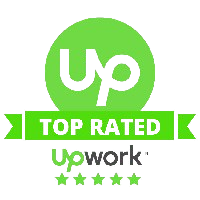Custom LMS Development
With everything available online these days—be it jobs or e-books—the inclination for remote learning is also on the rise. This has significantly accelerated the number of people engaging in online education over the world.
In 2023, the worldwide LMS for small businesses and LMS for enterprises’ market was valued at approximately $9.98 billion. By 2033, it is projected to grow to almost $63.12 billion, with an annual growth rate of 20.24% from 2023 to 2033. (Source – springsapps.com)
The EdTech industry is growing rapidly and if you’re thinking about building a Learning Management System for your business enterprise, then be assured that there’s no better time than now. In this comprehensive guide, we will walk you through the benefits of developing a custom LMS (Learning Management System), how you can develop one from scratch, and what are the future trends of custom LMS development. Read on to find out.

What is a Custom Learning Management System (LMS)?

Limitations of SaaS LMS Platforms
SaaS LMS platforms offer convenience and fast deployment, but they often lack the flexibility and control required for complex corporate training environments. Here are some key drawbacks to consider.
Limited Customization
Feature Overload or Gaps
Integration Challenges
Scalability Constraints
Recurring Costs
Data Security & Compliance Limitations
Have a project you wanted to discuss?
Free project quote
Please fill out the enquiry form below and we’ll establish communication with you as soon as possible

Lee Zinser
Founder at Needgr8r
"Team is great to work with.. They get what you need and action it with great results. Him has worked with us for a few years on various web related projects.. They are problem solvers and give valuable suggestions regarding the project. They are very fair and work fast. We are using them on continued projects. Thanks!"
Source: Upwork.com
Add Your Heading Text Here


Benefits of Choosing Custom LMS Development
Custom LMS is vital for organizations aiming to create personalized and effective learning environments. Unlike off-the-shelf systems, a custom LMS will be designed with your unique requirements in mind to ensure a user-friendly and efficient training experience.
Tailored for Your Business
One of the key benefits of a Custom LMS is that it is tailored specifically to your business needs, workflows, and goals. Unlike off-the-shelf solutions, a custom LMS can be designed to align with your organizational structure, branding, and unique training requirements. Whether you need industry-specific compliance modules, role-based access, custom reporting, or integration with internal systems like HRM or ERP, a custom solution ensures everything fits seamlessly. This level of customization not only enhances operational efficiency but also provides a more relevant and engaging learning experience for your employees, leading to better adoption and measurable outcomes.
Time-Efficiency and Cost Savings
Investing in a custom LMS for small businesses can lead to significant time savings and cost reduction in the long run. While the initial investment may be on the higher end, it results in long-term savings. You avoid the recurring subscription fees associated along with third-party LMS platforms. There are no ongoing licensing fees and you can schedule and budget your maintenance charges according to your organization’s needs.
On the other hand, by automating and centralizing training processes, you reduce the need for manual intervention, thus speeding up the delivery and improving efficiency.
Training and Upskilling
Building your own LMS gives you the major opportunity of training and upskilling your team or your employees with ease. The custom LMS will ensure that the system aligns with your learner requirements and training objectives. You can tailor the platform to include features like personalized learning paths, role-specific dashboards, and unique reporting metrics.
For example, an organization’s sales team could require integration with CRM tools in order to align their training with sales targets.
LMS API Integrations Capabilities
A custom LMS can be seamlessly integrated with other tools and systems your organization uses, such as CRM systems, HR software, and e-commerce platforms. This feature streamlines processes and improves efficiency.
Implementing Single Sign-On (SSO) permits users to access the system with their existing credentials. This not only reduces the hassle of managing multiple accounts but also improves security.
Ease of Updates and Scalability
A custom-developed LMS is designed to grow with your organization. It allows easy updates and modifications ensuring your system remains current with your organization’s evolving needs and technological advancements.
Additionally, as your organization expands, it can scale accordingly to accommodate increased numbers of users as well as additional training modules, thus providing a sustainable solution for long-term growth.
Data Security and Privacy
LMS development for enterprises provides strong security measures tailored to your organization’s needs. This includes compliance with industry-specific standards such as GDPR or HIPAA, advanced encryption for data protection, and customizable access controls to ensure that only authorized personnel can access sensitive information.<br><br>These tailored security features help maintain the integrity and protect against data breaches.
The Custom LMS Setup Guide: 6 Key Steps
Step 1: Discover What You Need
The first step before you start customizing your LMS is analyzing what you and your learners need. During the discovery and analysis stage, you should scrutinize your reasons for developing a custom LMS – what your goals are for the program, what you need to customize, and what would be a “nice-to-have.” Take the budget factor into consideration as well. Identify who will use it, outline your business goals, and analyze the market to find gaps and opportunities.
By setting clear goals and detailing out features, you’ll have a roadmap and can keep your project on track.
Step 2: Technical Architecture
Before starting the project we have to choose the appropriate infrastructure and technologies for frontend and backend development. Consider AI integrations and a suitable AI/ML technology stack.
Consider using frameworks like Vue or React to create a responsive and interactive user interface on the frontend. For the backend, choose robust technologies like Python or Node.js to handle server-side logic and operations. In order to manage and store data securely, select a reliable database system, such as MySQL or PostgreSQL. Also, consider using cloud services like Google Cloud or AWS for scalable and reliable hosting solutions.
Step 3: Design Your Academy
After all that technical jargon, now comes the interesting part. For this part, you need to utilize your creative skills and create a learning environment that not only reflects your brand, but at the same time, offers a one-of-a-kind learning experience that you’re seeking to provide. At this stage, we focus on LMS UI/UX Design – creating mockups, branding, wireframes, style guides, and user pathways.
Pay attention to the layout, ease of navigation, and accessibility features to ensure that the LMS is user-friendly and intuitive. Take note of feedback from potential users and stakeholders in order to refine and improve the interface. A smooth UX and intuitive UI can enhance the learning experience.
By investing in design, you can reduce the learning curve and improve user engagement and satisfaction.
Step 4: QA Testing
A Quality Assurance Testing will allow you to test every aspect of your LMS design, from the navigation through modules, courses, and learning paths, to the feel of the user interface, to the technical aspects like mobile responsiveness. Engaging in this QA period before you launch can help find and fix bugs before launching, boosting user satisfaction and trust. A well-tested system is more likely to perform well under different user loads and conditions.
Step 5: Activate Integrations and Launch
Before the final launching of your custom LMS, remember to activate any integrations you or your learners may require. For example, if you’re taking advantage of a CRM-LMS integration, make sure HubSpot or Salesforce are working properly. Similarly, if you’re relying on Zapier to automate some tasks, you’ll want to make sure it’s working as expected.
With that off the plate, you are ready to launch. This development phase is where your custom LMS comes to life. By developing and testing each component, you ensure that the system is functional and robust. Make sure to launch your LMS on a reliable hosting platform where users can access it.
Step 6: Ongoing Maintenance and Support
Wait! Your work is not finished yet. Even after the launch, there’s still more you can do to provide ongoing support.
To keep your LMS running, make sure to regularly update it, fix any issues, and make improvements on time. This helps you adapt to new demands, technologies, and meet user needs as they change. It is also essential to regularly monitor the system’s performance and implement updates and maintenance to address any existing issues, enhance security, and also introduce new features.
Future Trends in Custom LMS Development
Not only does AI help personalize education, analyzing the way students learn, providing immediate feedback, and recommending learning paths to each individual, but it also takes care of routine tasks for teachers, automating tasks such as suggesting content, analyzing performance, and grading, etc. This significantly reduces administrative work.
Microlearning is the best method for corporate training, as it lets employees quickly acquire new skills without intervening in their work. Additionally, adding quizzes and leaderboards to these short lessons can make learning more engaging and motivating.
Cloud-based LMSs being scalable, flexible, and cost-effective, will continue to lead the industry. They easily connect with tools like HR systems and CRMs. Plus, these platforms offer AI-driven analytics, which give valuable insights into individual learner’s progress and engagement.
Request a No-Obligation free consultation

Train Corporate Employees using Learning Management System
How Do You Choose The Right Learning…
Testimonials


"Lee Zinser"
Source: Upwork.com

"Kirsti Hegg"
"So far, JustAddWater has created high-functioning software to help overcome business challenges and better support sales. The team is consistently responsive and available, always making time to talk or fix any issues. Collaborative and open, they are quick to respond to questions and feedback."

"Rupert Pluck"
Source: Clutch.co

"Mohamed Hegazy"










